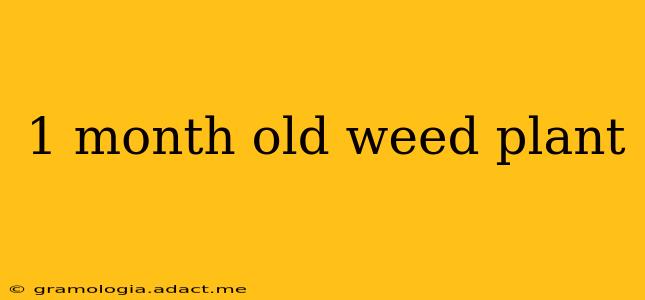A one-month-old cannabis plant is a tiny seedling, full of potential but also vulnerable. This crucial stage requires careful attention to ensure healthy growth and a bountiful harvest later on. This guide will cover everything you need to know about caring for your one-month-old weed plant, addressing common concerns and providing expert advice.
What Does a 1-Month-Old Weed Plant Look Like?
At one month, your cannabis plant should have several sets of true leaves (the serrated, fan-shaped leaves characteristic of cannabis), having moved beyond the initial cotyledon leaves (the first, seed-produced leaves). The plant's stem should be relatively thin but sturdy, and the overall height might be anywhere from a few inches to a foot depending on the strain and growing conditions. It's important to note that genetic variations significantly impact growth rates.
How Big Should a 1-Month-Old Weed Plant Be?
There's no single answer to this question. The size of a one-month-old cannabis plant depends heavily on factors like genetics (strain), growing medium (soil, hydroponics, etc.), lighting (intensity and type), and overall growing conditions. Some strains are naturally faster-growing than others. A healthy plant will show consistent, steady growth, with new leaves and stem elongation visible. If your plant seems stunted or unusually small, investigate potential problems (discussed below).
What are the Common Problems with a 1-Month-Old Weed Plant?
Several issues can hinder the growth of a young cannabis plant. Let's address some common concerns:
H2: My 1-Month-Old Weed Plant is Small – What Should I Do?
Several factors could be responsible for a small plant:
- Insufficient Light: Cannabis plants require ample light for healthy growth. Ensure your plant receives at least 18 hours of light per day, ideally from a grow light tailored for cannabis cultivation. Insufficient light intensity or duration can drastically stunt growth.
- Nutrient Deficiency: Young plants have specific nutrient requirements. Using a nutrient solution formulated for seedlings is crucial. Too little or too much fertilizer can harm growth.
- Watering Issues: Overwatering or underwatering can both stress the plant. Ensure the soil is consistently moist but not soggy. Allow the top inch or two of soil to dry slightly between waterings.
- Pests or Diseases: Inspect your plant regularly for signs of pests (aphids, spider mites) or diseases. Early detection and treatment are essential.
H2: My 1-Month-Old Weed Plant is Leggy – What Should I Do?
Legginess (excessive stem elongation with sparse leaves) is often a sign of insufficient light. The plant stretches towards the light source. Increase the intensity or proximity of your grow light to address this.
H2: My 1-Month-Old Weed Plant Has Yellowing Leaves – What Should I Do?
Yellowing leaves can indicate various problems:
- Nutrient Deficiency: Check your nutrient levels. Yellowing can signify a lack of nitrogen, iron, or other essential nutrients.
- Overwatering: Soggy soil can suffocate roots and cause yellowing. Allow the soil to dry out slightly between waterings.
- pH Imbalance: The pH of your soil or nutrient solution can affect nutrient uptake. Ensure your pH is within the optimal range for cannabis.
- Over-fertilization: Too much fertilizer can "burn" the roots and cause yellowing. Flush the soil with plain water to remove excess salts.
H2: What is the best type of light for a 1-month old weed plant?
For seedlings, LED grow lights are often preferred due to their efficiency and ability to provide the specific spectrum of light cannabis needs during its vegetative stage. Ensure the light is positioned appropriately to avoid burning the delicate leaves.
Remember, consistent observation and proactive care are key to successfully nurturing your young cannabis plant. Pay close attention to its growth, and don't hesitate to seek advice from experienced growers or online communities if you encounter unforeseen challenges. This initial month establishes the foundation for the plant’s future development. Careful tending now will yield better results later.
